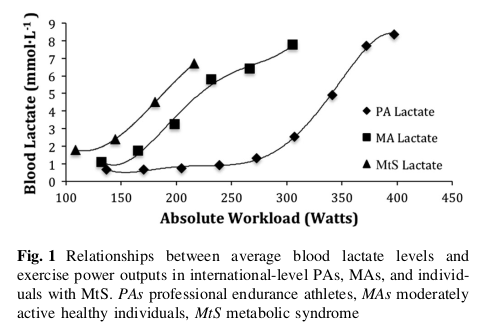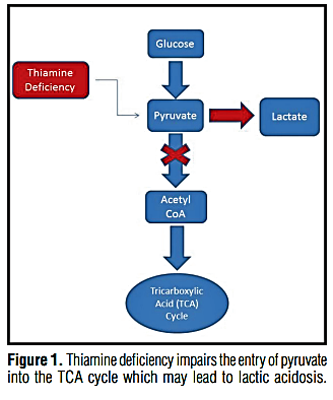Exercise, the Only Known “Medicine” for Maintaining and Improving Mitochondrial Function
-
Dr. Peat had stated that high levels of lactate are associated with increased mortality, as seen in patients with levels above 2 millimoles per liter. But exercise is known to increase blood levels of lactic acid. In the past, I have had trouble reconciling these two ideas.
The paper below illustrates that blood lactate levels are lower in aerobically conditioned people. During exercise the blood levels increase, but the increase is only temporary. This seems to be similar to the temporary increase in blood pressure during exercise.


The Key Role of Mitochondrial Function in Health and Disease (2023)
-
@DavidPS
It looks like the OP paper and its ref [24] are still in sync with Dr. Peat's claims that elevated lactate is a sign of mitochondrial dysfunction (inflexibility).
The 2mmol/L number is interestingly showing in the plot below (from ref [24]).
PA's are quickly go into fat oxidation while MtS's are stuck in aerobic glycolysis, exhibiting excessive amounts of blood lactate, even for small workloads.
[24] Assessment of Metabolic Flexibility by Means of Measuring Blood Lactate, Fat, and Carbohydrate Oxidation Responses to Exercise in Professional Endurance Athletes and Less–Fit Individuals. Sport. Med. 2018, 48, 467–479. [Google Scholar]
-
@DavidPS
Another interesting dig referencing the OP paper is
Successfully Reducing Sitting Time Can Improve Metabolic FlexibilityFrom the abstract:
In secondary analyses, those who successfully reduced sedentary time by at least 30 min/day (n = 34) improved insulin-stimulated MetFlex and low-intensity exercise fat oxidation compared to the continuously sedentary (n = 30) [ΔRER +0.03 (-0.01, 0.07) vs. -0.02 (-0.06, 0.03); and FATox +0.2 (-0.3, 0.7) vs. -0.4 (-1.0, 1.0) mg/kg/min, group * time p < 0.05]. -
If I have particularly lazy days laying around, my legs will be so stiff and I will generally have a low grade ache everywhere. When I am super active working and walking alot it’s easier to just keep moving and keep doing physical activity. So my perception lines up with that study David. Even in my past when I would get sick for a few days laying and resting in the couch I make myself get up and walk around and move because there is just too much lactic acid built up and it sucks. Thanks for sharing and it’s a great reminder to keep up physical activity.



-
@Lejeboca - Thanks for the interesting links. Especially for the image.
-
I think I get it now. It's good to go to the limit of glucose oxidation and exercise is the obvious way to get there. The benefits to mobilizing all that glucose outweigh the damage from minor fat/lactase oxidation, as long as you have enough glucose and don't do something stupid like long distance running.
-
@pittybitty running 5km is actually kind of based tbh idk if thats long distance to you but it feels hella good at the end usually. its a fast track to a nearly religious euphoria tbh
-
@sunsunsun stress hormones are addictive
-
@pittybitty kekw
-
@pittybitty sugar feels good and is not bad but running 5km feels good but is le bad
-
I implore you to look at the different disciplines and the people who perform them and judge their level of health. Distance runners are less healthy than people who do not exercise at all. It's a sport that makes you sick. Same thing with food, look at the results, not what people say.
-
@dapose said in Exercise, the Only Known “Medicine” for Maintaining and Improving Mitochondrial Function:
If I have particularly lazy days laying around, my legs will be so stiff and I will generally have a low grade ache everywhere.
Absence of exercise impacts
Short answer
- Thiamine deficiency leads to excess lactate

Source: Lactic Acidosis: A Lesser Known Side Effect of Thiamine
Carol Rees Parrish, M.S., R.D. In Nutrition Issues in Gastroenterology, Series #161 - You miss thiamine (B1) from conventional food sources
Our typical diet covers approximately 45 to 53% of your daily vitamin B1 requirements. And I don’t mean eating fast-food but a conventional one.
B1 from food = ~50% of needs → supplement provides the remaining ~50%.
A B50 2x/wk. brings 14–16 mg/day on average. I won’t take a B50 complex every day.
=> Probably.0.5 mg per additional 1000 K/cal. So, RDA 1.2 mg + 0.5 mg = 1.7 mg for 3 000 K/cal.
A target intake around 1.6–1.8 mg/day of thiamine is a reasonable nutritional estimate, but not a medical prescription. - Magnesium helps to a certain extent.
- What vitamins help with acidosis? Which proportion as a prevention?
- Useful info and links
- Muscle pain, lactic acid and thiamine B1 – A myth? No so far, for my personal case.
- Average deficiency in vitamin status
High deficit for B1 (70-80%), B2 (60%), B9 (90%), C (60%), A (15%), E (75% W – 40% M), D (90%), iron (90% W – 5% M) and magnesium (80% W – 60% M). (ESVITAF, 1986). - Impact of a moderate amount of alcohol (2 glass wine or 2 beers), as an extra precaution: ~0.3–0.5 mg/day more.
Extra info on my forum if you want details:
https://mirzoune-ciboulette.forumactif.org/t2147-english-corner-how-to-avoid-excess-lactic-acid#30449 - Thiamine deficiency leads to excess lactate
